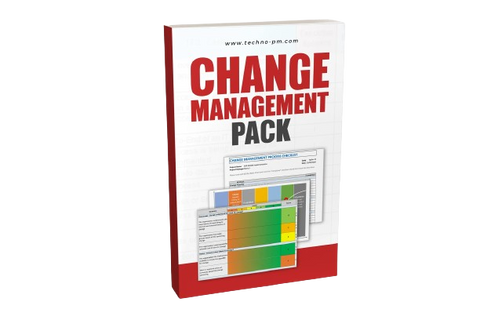Checklist Template for Your Change Management Process
Change Management Process
Change Management is a structured approach to transitioning individuals, teams, and organizations from the current state to a desired future state. It involves understanding, planning, implementing, and monitoring changes effectively. The process begins with identifying the need for change, followed by assessing its impact, creating a comprehensive change management plan, communicating the change to stakeholders, and finally, implementing strategies to ensure the change is adopted smoothly.

Change Management Checklist
Change Management Process Checklist
Due to the numerous aspects to consider and to make sure that nothing is forgotten, try using a process checklist. Checklists are powerful tools, and the more detailed, the better. However, it is fundamental that the checklists are not just used as a tick-box exercise – you should put sufficient thinking and preparation when going through each of its items! As a minimum, a Change Management Process Checklist should include information about the following:
1. Change Planning: This section includes details about the case for change, resources required, the change management plan and timescales, the change objectives and definition of the to-be state, or the change impact assessment.
2. Change Engagement: Engagement is a key part of the management of change; thus, it is no wonder that there is a section just for it. It should detail who will sponsor the change internally, which stakeholder groups will be impacted, how they feel about the upcoming change, and what the communications and engagement plan looks like. As importantly, it should check if there are mechanisms in place to address resistance to change.
3. Change Implementation: This section refers to the actual delivery of change. Therefore, it contains aspects such as process updates, training of end-users, and monitoring the execution of the change management plan.
4. Change Reinforcement: It’s not enough to deliver change; it also needs to be reinforced if it is to be successfully embedded in the organization's culture and day-to-day. Therefore, this section captured the details about the plans and vehicles available for reinforcement, such as future training, coaching, or the existence of change champions in the organization's various departments.
5. Change Evaluation: We won’t know if we have been effective in our change efforts unless we evaluate the change intervention. This evaluation should be carried out at the process level as well as at the outcome level. By doing so, lessons can be learned for future change endeavors, and the new to-be state of change can be validated against defined key performance indicators. Ultimately, this set of checks will allow us to respond to the question, “how do we know we got there?”.
Advantages of the Change Management Process Checklist
Checklists can be used at any point in the change project and serve as a fantastic tool for self-assessment, enabling individuals to identify their areas of strength and areas for improvement. In such a situation, checklists are created by a corporate Change Management department who will set the standards for change management and, in this way, enable consistency on how change is managed in the organization and by the various projects.
Yet, the Change Management Process Checklist's key purpose is to ensure that no steps fall through the cracks; that is, the checklist should be action-oriented. If any of the checks is not fulfilled, it should be addressed as soon as possible, rather than skipped. After all, the robustness of the change management process is translated into the change management process checklist. Do take your time to go through each step, don’t rush it!
Checklists are great for navigating complex systems or processes, thus ideal for change management. At the end of the day, the checklist's purpose is to make your work and life easier, not to slow you down. It should give you the joy of removing items from your to-do list – that amazing feeling of confirming that you have done everything you were supposed to do, no critical step left behind. Checklists are for getting things done – now, let us get that change done, shall we?






